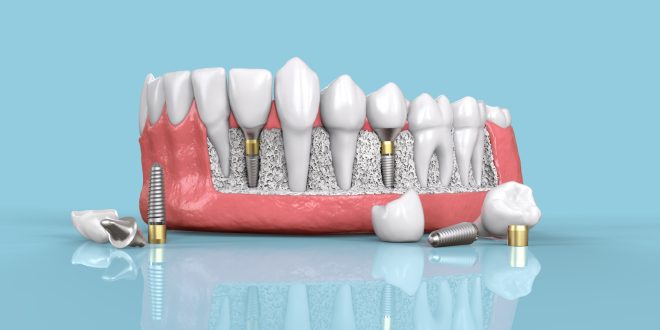For many individuals, missing teeth can lead to various challenges beyond just aesthetic concerns. Chewing, speaking, and the alignment of adjacent teeth can all be affected. Thankfully, dental implants offer a robust solution, mimicking the natural structure and function of teeth to restore not just smiles, but overall oral health.
Whether you’re considering this option for yourself or seeking to broaden your knowledge in the field of dental health, this comprehensive guide to dental implants will provide clarity on the various types, procedures, and costs involved.
What Are Dental Implants?
Dental implants are prosthetic replacement tooth roots that are surgically anchored into the jawbone. They serve as a stable base for supporting single or multiple artificial teeth known as crowns, bridges, and dentures. Made of titanium, a biocompatible material that naturally integrates with the jawbone, implants are the gold standard in tooth replacement options due to their durability and life-like appearance.
Who Is A Candidate For Dental Implants?
Not everyone is immediately suitable for dental implants. Candidates typically need to have good general and oral health, sufficient bone structure to support the implant, and healthy gums. If there is an issue with any of these factors, a dentist can work with you on a treatment plan to address them and prepare you for implant surgery. Age is not a barrier; implants can be a viable option for both younger and older patients.
Different Types of Dental Implants
There is not a one-size-fits-all approach to dental implants. The type used will depend on various factors, including the patient’s needs, the dentist’s assessment, and the location within the mouth.
Endosteal Implants
Endosteal implants are the most common type and are surgically implanted directly into the jawbone. Once the surrounding gum tissue has healed, a second surgery is needed to connect a post to the original implant. Lastly, an artificial tooth, or crown, is connected to the post either individually or grouped on a bridge or denture.
Subperiosteal Implants
Subperiosteal implants consist of a metal frame that is fitted onto the jawbone just below the gum tissue. Posts attached to the frame protrude through the gums, allowing the artificial teeth to be mounted on them. This type of implant is used when endosteal implants are not an option due to the depth or width of the patient’s jawbone.
Zygomatic Implants
Zygomatic implants are an alternative for patients who lack sufficient jawbone for traditional implants and are not candidates for bone grafting. These implants are longer and anchored in the upper jawbone near the cheekbone (zygomatic bone) rather than the maxillary bone that is closer to the sinus cavities.
All-on-Four
The All-on-Four treatment concept provides a permanent, screw-retained replacement for the entire upper and/or lower set of teeth. This is strategically placed using four dental implants to support a full-arch fixed bridge.
In the realm of dental implants, the choice of high-quality products is paramount to achieving lasting and natural-looking results. Among the leaders in this industry is OEMDent, renowned for their superior dental implant products. They offer a comprehensive line of implants and related accessories, designed to meet the diverse needs of patients and dental professionals alike.
How Much Do Dental Implants Cost?
The cost of dental implants can vary significantly depending on several factors, including the type of implant, the material used for the implant, the number of teeth being replaced, the location of the dental practice, and any additional procedures that may be needed, such as tooth extraction or bone grafting.
Price Breakdown
- Initial Consultation: Dentists typically charge for the initial consultation, during which they will assess your suitability for implants and discuss your treatment plan.
- Implant Surgery: This is the cost of the surgical placement of the implant into the bone.
- Abutment and Crown: After the implant has integrated into the bone, a connector (abutment) is placed on top of the implant to hold the crown.
- Additional Procedures: If you require a bone graft or a sinus lift to help create a more solid base for the implant, these will be additional costs.
Insurance and Financing
Dental insurance does not always cover implants, as it is often considered a cosmetic procedure. However, some insurance plans may offer partial coverage, particularly when implants are needed for reasons beyond aesthetics, such as the ability to chew properly. Alternatively, many dental offices offer financing plans to help cover the cost of treatment.
Long-Term Investment
Although the cost of dental implants may seem higher than alternative treatments, their durability, and the fact that they don’t decay like natural teeth, can make them a cost-effective option in the long run. They are an investment in your oral health and quality of life.
How Does Dental Implant Surgery Work? Step-By-Step
Understanding the process of dental implant surgery can help alleviate any apprehension you might have about the procedure. Here is a step-by-step overview:
Initial Consultation and Treatment Planning
The first step is an initial consultation where your dentist will examine your teeth and take X-rays and molds of your teeth and jaw. This is to determine the extent of the treatment and can involve specialists such as oral surgeons and periodontists who focus on the supporting structures of the teeth.
Dental Implant Placement
The next step is the surgical placement of the implant into the jawbone. The gum is then secured over the implant, which will be left to heal and integrate with the bone for a few months. Some patients may require a bone graft to strengthen their jawbone first, particularly if they have experienced bone loss.
Attaching the Post (Abutment)
Once the implant has bonded with the jawbone, a second surgery is typically required to place the abutment. This is an extension of the implant’s metal post, designed to hold the new tooth. Alternatively, the abutment may be attached to the implant at the time of the initial surgery.
Placing the Artificial Tooth
Finally, after the soft tissue heals over the abutment, your dentist will take impressions of your bite and the surrounding teeth. These impressions will be used to create a dental crown that will be attached to the abutment, completing the process.
Recovery and Aftercare
After surgery, it’s essential to practice meticulous oral hygiene to ensure short and long-term success of your implants. Pain at the implant site, minor bleeding, and swelling of the gum and face can occur, but these symptoms should subside in a few days. Your dentist will provide you with instructions and may recommend a diet of soft foods, cold foods and warm soup the day of surgery.
Conclusion
For those considering dental implants, it’s crucial to seek a reputable and experienced dental professional who can guide you through the process from start to finish. With the knowledge of the different types of implants, the financial considerations, and the surgery procedures, you’re on your way to making an informed decision about this life-changing treatment.
 Isaiminia World Breaking News & Top Stories
Isaiminia World Breaking News & Top Stories




